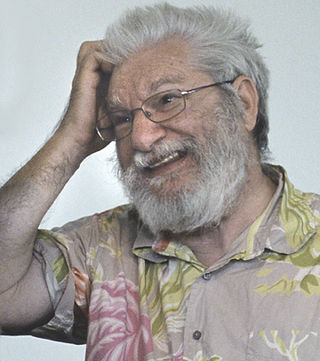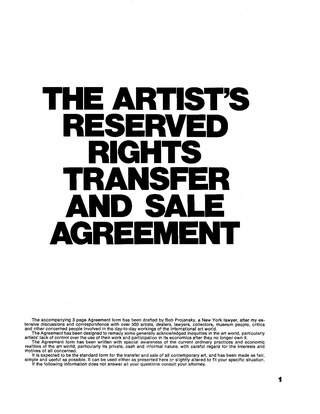Conceptual art, also referred to as conceptualism, is art in which the concept(s) or idea(s) involved in the work take precedence over traditional aesthetic, technical, and material concerns. Some works of conceptual art, sometimes called installations, may be constructed by anyone simply by following a set of written instructions. This method was fundamental to American artist Sol LeWitt's definition of conceptual art, one of the first to appear in print:
In conceptual art the idea or concept is the most important aspect of the work. When an artist uses a conceptual form of art, it means that all of the planning and decisions are made beforehand and the execution is a perfunctory affair. The idea becomes a machine that makes the art.

Art & Language is a conceptual artists' collaboration that has undergone many changes since it was created in the late 1960s. The group was founded by artists who shared a common desire to combine intellectual ideas and concerns with the creation of art. The first issue of the group's journal, Art-Language, was published in November 1969 in England.

Victor Burgin is a British artist and writer. Burgin first came to attention as a conceptual artist in the late 1960s and at that time was most noted for being a political photographer of the left, who would fuse photographs and words in the same picture. He has worked with photography and film, calling painting "the anachronistic daubing of woven fabrics with coloured mud". His work is influenced by a variety of theorists and philosophers, most especially thinkers such as Sigmund Freud, Henri Lefebvre, André Breton, Maurice Merleau-Ponty, Michel Foucault and Roland Barthes.

Joseph Kosuth, an American conceptual artist, lives in New York and London, after having resided in various cities in Europe, including Ghent and Rome.
Information art, which is also known as informatism or data art, is an emerging art form that is inspired by and principally incorporates data, computer science, information technology, artificial intelligence, and related data-driven fields. The information revolution has resulted in over-abundant data that are critical in a wide range of areas, from the Internet to healthcare systems. Related to conceptual art, electronic art and new media art, informatism considers this new technological, economical, and cultural paradigm shift, such that artworks may provide social commentaries, synthesize multiple disciplines, and develop new aesthetics. Realization of information art often take, although not necessarily, interdisciplinary and multidisciplinary approaches incorporating visual, audio, data analysis, performance, and others. Furthermore, physical and virtual installations involving informatism often provide human-computer interaction that generate artistic contents based on the processing of large amounts of data.

Adolph Dietrich Friedrich Reinhardt was an abstract painter active in New York for more than three decades. He was a member of the American Abstract Artists (AAA) and part of the movement centered on the Betty Parsons Gallery that became known as abstract expressionism. He was also a member of The Club, the meeting place for the New York School abstract expressionist artists during the 1940s and 1950s. He wrote and lectured extensively on art and was a major influence on conceptual art, minimal art and monochrome painting. Most famous for his "black" or "ultimate" paintings, he claimed to be painting the "last paintings" that anyone can paint. He believed in a philosophy of art he called Art-as-Art and used his writing and satirical cartoons to advocate for abstract art and against what he described as "the disreputable practices of artists-as-artists".

Robert C. Morgan is an American art critic, art historian, curator, poet, and artist.

Marcel Broodthaers was a Belgian poet, filmmaker, and visual artist with a highly literate and often witty approach to creating art works. In 1943-1951 he was a member of a Communist party.

Lawrence Charles Weiner was an American conceptual artist. He was one of the central figures in the formation of conceptual art in the 1960s. His work often took the form of typographic texts, a form of word art.

Daniel Graham was an American visual artist, writer, and curator in the writer-artist tradition. In addition to his visual works, he published a large array of critical and speculative writing that spanned the spectrum from heady art theory essays, reviews of rock music, Dwight D. Eisenhower's paintings, and Dean Martin's television show. His early magazine-based art predates, but is often associated with, conceptual art. His later work focused on cultural phenomena by incorporating photography, video, performance art, glass and mirror installation art structures, and closed-circuit television. He lived and worked in New York City.

Seth Siegelaub was an American-born art dealer, curator, author, and researcher. He is best known for his innovative promotion of conceptual art in New York in the 1960s and '70s, but has also been a political researcher and publisher, textile history bibliographer and collector, and a researcher working on a project on time and causality in physics.
In art, institutional critique is the systematic inquiry into the workings of art institutions, such as galleries and museums, and is most associated with the work of artists like Michael Asher, Marcel Broodthaers, Daniel Buren, Andrea Fraser, John Knight (artist), Adrian Piper, Fred Wilson, and Hans Haacke and the scholarship of Alexander Alberro, Benjamin H. D. Buchloh, Birgit Pelzer, and Anne Rorimer.
Charlie Gere is a British academic who is professor of media theory and history at The Lancaster Institute for the Contemporary Arts, The University of Lancaster and previously, director of research at the Institute for Cultural Research at The University of Lancaster. He is author of several books and articles on new media art, art and technology, continental philosophy and technology. His main research interest is in the cultural effects and meanings of technology and media, particularly in relation to post-conceptual art and philosophy.
Art in Ruins was formed in 1984 as a collaborative interventionist practice in art and architecture, staging exhibitions and publishing texts, by Hannah Vowles and Glyn Banks.

Robert Carleton Hobbs is an art historian and curator specializing in twentieth-century art. Since 1991 he has held the Rhoda Thalhimer Endowed Chair of American Art in the School of Arts, Virginia Commonwealth University, a highly ranked art department. Since 2004 he has served as a visiting professor at Yale University. He has held positions at Cornell University, University of Iowa, Florida State University, and Tehran Museum of Contemporary Art in Iran, and is known for a number of books, in-depth essays, and exhibitions.
Charles Townsend Harrison, BA Hons (Cantab), MA (Cantab), PhD (London) was a UK art historian who taught Art History for many years and was Emeritus Professor of History and Theory of Art at the Open University. Although he denied being an artist himself, he was a full participant and catalyst in the Art and Language group.
Christopher D’Arcangelo was an American artist who worked in the 1970s until his death in 1979. He was the son of the American painter Allan D'Arcangelo.
Abraham (Abe) Ajay (1919–1998) was an American artist who was best known for his artistic contributions for The New Masses magazine during the late 1930s and early 1940s. and also for his creative use of reliefs made of found objects during the 1960s and beyond. Abraham Ajay was born in Altoona, Pennsylvania in 1919 to Syrian immigrant parents. Ajay grew up working at his father's candy store and bar in Altoona until he graduated from high school. From an early age, Ajay had a passion for art and sought to harness his artistic abilities when he made the decision to move to New York City to study at the Art Students League of New York, and the American Artists School in Manhattan.
Post-conceptual, postconceptual, post-conceptualism or postconceptualism is an art theory that builds upon the legacy of conceptual art in contemporary art, where the concept(s) or idea(s) involved in the work takes some precedence over traditional aesthetic and material concerns. The term first came into art school parlance through the influence of John Baldessari at the California Institute of the Arts in the early 1970s. The writer Eldritch Priest, specifically ties John Baldessari's piece Throwing four balls in the air to get a square from 1973 (in which the artist attempted to do just that, photographing the results, and eventually selecting the best out of 36 tries as an early example of post-conceptual art. It is now often connected to generative art and digital art production.
Christine Kozlov was an American conceptual artist.










